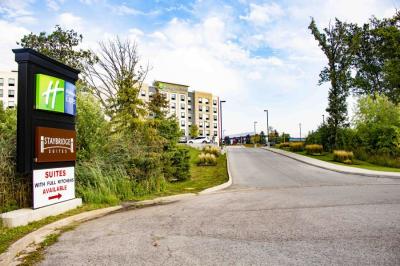A parking lot and road were built without permission on top of an environmental conservation area near the Holiday Inn on York Road and now the developer is looking to get approval after the fact by having the area rezoned.
The road was built to connect Counsell Street and Glendale Avenue, which are separated by conservation land.
The unsanctioned construction came to light during a public meeting regarding 524 York Rd. held during a committee of the whole session on Monday.
Coun Norm. Arsenault was vocal in his criticism.
“You know, it never ceases to (amaze) me about the audacity of developers, the way they do this. They take over, in this case, something like 60 feet of conservation land, do what they want, and they come back looking for approval after the fact,” he told councillors.
“It just makes me crazy when I see developers taking over conservation areas like this without asking permission. I will not support this, I cannot support this,” Arsenault continued before being reminded by Lord Mayor Betty Disero that the meeting was an open house and not the venue for councillors to express their opinions.
Disero later apologized to Arsenault through Zoom chat.
The area in question includes a Holiday Inn Express and Staybridge Suites, both developed by the Vrancor Group.
The west side of the developed lot is bordered by an environmental conservation area separating the lot from Glendale Avenue.
The developer had always planned to build a parking lot and connecting road through the area, said Susan Smyth, a land use planner with Quartek Group Inc., appearing on behalf of Vrancor.
But the construction was not approved as part of the development’s first phase but the company built the parking lot and road on top of the conservation land anyway.
“Although constructed early and prematurely, this area was always part of the overall development master plan,” Smyth told council.
She said rezoning would rectify the “non-compliance issue,” a term she repeatedly used to describe the unapproved construction.
The phase one construction plan was approved by the previous council under then-Lord Mayor Pat Darte in 2017. The parking lot and connecting road were part of the unapproved phase two master plan, Smyth said.
Town planner Rick Wilson stressed throughout his presentation that this construction was done independent of the town or region.
“The developer did this construction beyond the limits of what was approved,” he repeatedly told councillors.
He said the work must have taken place sometime in late 2017 into 2018.
Wilson said the developer was required to submit a study showing that ecological features would not be affected by the proposed development.
Vrancor submitted its report after the work had already been completed but the report claimed the studies had been done in 2016 and 2017, before construction took place.
The assessment is now in the hands of the Niagara Region for review. The region is responsible for natural heritage features, Wilson said.
The region noted the “recommendations and mitigation measures contained in the environmental impact study are insufficient to address the construction encroachments,” he said.
Wilson said the region wants more information.
According to the submitted assessment, no species at risk or significant wildlife habitat was affected by the construction.
Significant wildlife habitat referred to areas for snake hibernation or deer wintering. The Ministry of Natural Resources and Forestry Services’ Anne Yagi and Natural Resource Solutions Inc., were involved in the assessments. It was signed by Barry Myler, a biologist with Myler Ecological Consulting.
Myler spoke in defence of the developer.
“There were no species at risk found. Like, zero,” he emphasized.
Coun. Gary Burroughs noted part of Six Mile Creek extends up through the area, and salmon and trout have been seen migrating there.
Myler said the construction completed on the conservation land was purely “terrestrial” as a culvert crossing had been previously built under the area for the creek.
Smyth noted that no sensitive fish species or fish habitat were found, meaning the Niagara Peninsula Conservation Authority had no jurisdiction. She said the agency had no concern in its most recent comments.
Coun. Sandra O’Connor raised the issue of mammal crossings in the area but Myler said mammals would be minimally affected.
“Birds can still fly from one tree to another or terrestrial wildlife could still cross a two-lane driveway,” he said.
Myler pointed to the impediments caused by York Road and the Queen Elizabeth Highway as far greater impediments for wildlife than the new roadway.
“We don’t have herds of deer moving through here or anything like that. We’re really just talking about the squirrels and rabbits and the neighbourhood birds,” he told council.
The potential rezoning will come before council for approval at a later date.











